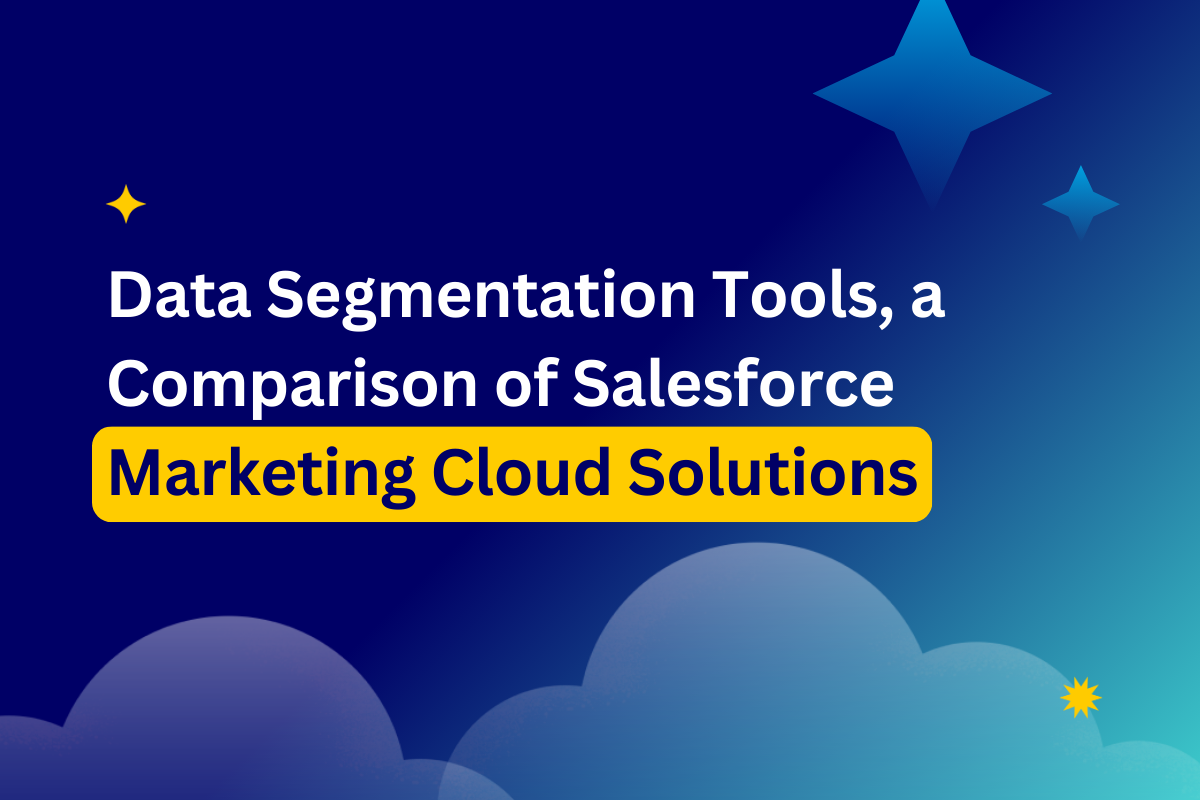
Data Segmentation Tools, a Comparison | DESelect
Marketing teams must find efficient and effective methods to reach their audience quickly for every campaign they launch. Salesforce Marketing Cloud (SFMC) segmentation tools make collecting this data easier than ever.
You basically have three solutions available:
- No-code solutions, like using SF filters, SF Reports, or Excel, to name a few
- Coding solutions, like SQL, Query Studio, or SAS
- Hiring external help, like full-time employees (FTE) or system integrators
Choosing the best audience segmentation approach for your organization means knowing the advantages and disadvantages of each of these solutions.
This in-depth guide will give you all the information you need to decide which segmentation tools will work best for you and your marketing team.
What are the Key Features of SFMC Segmentation Solutions?
Here are some of the features of SFMC segmentations tools you should check:
Ramp-up time & Implementation
The amount of time it takes to prepare and integrate the segmentation tool into your current campaign module. Knowing the amount of time required to complete this process is vital to determine which tool will work best for your organization.
Data storage
The amount of data storage you need will determine which solution is best for your audience segmentations. Furthermore, consider whether additional storage costs are acceptable if you need to scale up as your leads list grows.
Experience/Skills Required
The skill level of the marketer running these segmentation tools will affect the time it takes to launch a campaign. It will also affect costs, as these tasks take away from more cost-effective tasks marketers must do, like content creation.
Pricing
The price point should be within your budget. However, consider the adage “you get what you pay for,” and free is not always a “good price.”
Data Processing Speed
Waiting for hours or even an entire business day can seem like an excessive amount of time in terms of how long processing segmented data can take. Immediate data processing speed will help you launch your campaigns faster and reach your audience more effectively.
Data Accessibility
Being able to get to the data at any time of the day will help your team launch a more effective campaign.
Data Sources
How you can retrieve the data will determine which segmentation tool will work best for your organization. There are only a few that don’t offer easy access to data views. So, pay attention to the data source.
Flexible Data Model Adjustment for Marketers
You and your team may need to adjust the data models from time to time. If you have to wait for this information from an admin or if it isn’t available, it may delay campaign launches.
Data Availability for Segmentation
One crucial aspect to consider is whether there are limits on data availability and how often you can access this data if limitations apply. Segmentation without limits and in real time is the most desired outcome.
Integration with SFMC
How easy do you want your segmentation solution to integrate with SFMC? There may seem to be an obvious answer, so pay close attention to this detail if SFMC integration is vital to your marketing operations.
User Experience
When considering user experience, determine whether the UI is user-friendly (if there is one) and how easy it is for you and your team to navigate. The comparison below will help you determine at a glance which segmentation tool will work for the issues and concerns that matter to you most.
What are the Advantages and Disadvantages of These Salesforce Cloud Marketing Segmentation Tools?
Here are some key advantages and disadvantages of each of the SFMC segmentation tools available:
DESelect Segment
Advantages:
- All data extension types
- Data views
- Advanced segmentation (incl. CASE WHEN, Picklists, Subqueries, etc.)
- Most cost-effective solution on the market
- Onboarding training
- Release updates every two month
- No implementation tracks
- No external support required
- Can be automated
- No experience required
- Can be used across several business units
- And more
Disadvantages:
- Data must be inside of SFMC
- Same technical limits as SQL queries
*Audience Builder
Advantages:
- Segments SFMC data
- Has its own UI
- No experience needed from marketers
Disadvantages:
- Data is updated only once per 24 hours
- No possibility to add new data extensions without Salesforce professionals
- Expensive
- Not flexible
Other concerns to consider:
This Salesforce solution requires a Salesforce professional’s help to set up the tool and configure dimensions. Also, it doesn’t suit flexible data models.
*Salesforce has discontinued offering Audience Builder to new customers and continues to serve it only to it’s existing users
Query Studio
Advantages:
- Help Write SQL
- Handles errors
- Preview options available
- Free
Disadvantages:
- Requires SQL knowledge
- No UI – the console is more advanced
- No automatic creation of data extensions
- No validation
- No support
- No features
Other concerns to consider:
Advanced knowledge of SQL is required, or you will need to use an SQL query generator. Since there is no UI, the console is difficult to use if you don’t have experience with that interface.
Writing SQL Queries
Advantages:
- Customizable coding
- Ability to write unique, tailored queries
Disadvantages:
- Timeouts occur for data sets that are too long
- Complex queries also cause timeouts
- Time-consuming
- Highly technical knowledge required
Other concerns to consider:
It takes a lot of time and effort to learn how to write SQL queries. You will need to learn SQL from scratch if you have no prior knowledge. You may request SQL from a tech team. However, coordinating communications to obtain the exact results is a challenge.
Hiring an FTE
Advantages:
- Advanced segmentation
- Custom segmentation scenarios
- Data model adjustments are possible
Disadvantages:
- Needs to be trained
- Can leave the company, creating a backlog
- Limited availability
- Expensive
Other concerns to consider:
If an organization hires an FTE for audience segmentation in SFMC campaigns, it may be prudent to sign a contract with them. If they leave, the organization will immediately require a new solution. However, it could take months to find, hire, and train a new FTE.
Also, if the FTE is remote (as many are), time zones can be an issue. Marketers rely on the FTE to be available for segmentation purposes, and without that person, they cannot effectively run their campaigns.
Sick time, vacations, and other time-off requests also become a concern for the organization if they hire an FTE for segmentation.
SAS EG/Google Cloud Platform
Advantages:
- Advanced segmentation
- Lead scoring
- RFM scoring
- And more
Disadvantages:
- Even more complex than SQL
- Require skilled FTEs
- Expensive
Other concerns to consider:
SAS EG platforms rarely occur. However, they occur mostly for calculations and aggregations in retail.
Salesforce Reports
Advantages:
- Picklists
- Create JOINs with a maximum of four data extensions
- Inexpensive
- Has a user-friendly UI
Disadvantages:
- Only INNER and OUTER JOINs are available
- Data migration
- Does not support data views
- Requires additional licenses
- Cannot be automated
Rarely will an organization utilize Salesforce reports for audience segmentation for its marketing campaigns. However, there are many more effective and efficient methods.
SFMC Filters
Advantages:
- No implementation required
- No experience required
- Can be automated
Disadvantages:
- Only INNER and OUTER JOINs
- Create JOINs with up to three data extensions
- No picklists
- Manually creating target data extensions required
- Limited filtering options
Other concerns to consider:
Filters in SFMC can be a solution for customers that don’t need to perform advanced segmentation with their audience. The primary issues are the limited number of DEs that can JOIN. Also, it takes substantial time to set up.
Excel
Advantages:
- Only requires knowledge of Excel
- Free (if you already have the MS Office Suite)
Disadvantages:
- Cannot be automated
- No error checks
- Unsecured data management (e.g., a marketer can change the data type and has no error)
- Manually creating target data extensions
- Data type issues
- Doesn’t support data views
- Can take a lot of time to load the data, and unsustainable for companies carrying big amounts of it
Other concerns to consider:
Using Microsoft Excel for audience segmentation is a very slow process with vast opportunities to make mistakes that are not easily found.
System Integrators
Advantages:
- Complex segmentation
- Data model adjustments
- Developing new segmentation scenarios
Disadvantages:
- High dependence on 3rd party
- If a professional is fired/changes job, the company is stuck for several days/months
- Expensive
- Time-consuming
- Can take days to get the desired result
Other concerns to consider:
Partners for audience segmentation work well in the implementation and design phases. However, it’s very expensive and time-consuming during campaign deployment rollout.
Interaction Studio
Advantages:
- Great personalisation and interaction management capabilities inside the app
- All-round information about the customer
Disadvantages:
- Doesn’t segment SFMC data
- Limited use of SFMC data (only gears)
- It’s on the more expensive end of the spectrum
What is the Best Solution for Audience Segmentation in Salesforce Marketing Cloud?
When it comes to Salesforce Marketing Cloud segmentation tools, you have several options. Many may work effectively for your business. However, if using Filters, hiring an FTE, or investing time to learn SQL yourself isn’t feasible, DESelect Segment is the best choice for your organization. It’s the most integrated, cost-efficient, and intuitive segmentation solution for SFMC.
If you are ready to implement SFMC for better audience segmentation, contact us here at DESelect. We can help you launch campaigns in a fraction of the time.
- What are the Key Features of SFMC Segmentation Solutions?
- What are the Advantages and Disadvantages of These Salesforce Cloud Marketing Segmentation Tools?
- What is the Best Solution for Audience Segmentation in Salesforce Marketing Cloud?
Latest Articles
-
Take the DESelect Marketing Operations Maturity Model Assessment
Take our free survey to assess and advance your marketing operations maturity model along two dimensions: automation and personalization. You'll receive your customer report in just a few days.February 27, 2025 -
Beyond Limits – Exploring Smart Communication Capping
Beyond Limits: Exploring Smart Communication Capping In this comprehensive guide, we explore why communication capping matters and how smart communication capping maximizes engagement, marketing ROI, and compliance. Why Communication Capping Matters In today’s landscape, customers can be overwhelmed with marketing messages across multiple channels. In our 2024 study of 234 consumers across the United States, […]February 18, 2025 -
Top 10 Marketing Operations Predictions for 2025
We’re excited to unveil our Top 10 Marketing Operations Predictions for 2025. The exponential growth of marketing automation, the impact of AI on strategy and execution, and the drive to become more intentional and data-driven means we’re going to see a lot of interesting dynamics and progress in marketing. As 2024 closes out, we took a step back to think about what the future holds for marketing operations and came up with our first-ever list of predictions. Let’s dive in!December 19, 2024 -
The Ultimate Guide to Salesforce Marketing Cloud Advanced Edition
At the Marketing Keynote at Dreamforce 2024, Salesforce announced an exciting expansion to its suite of marketing solutions — the Marketing Cloud Advanced Edition, which builds upon the existing Marketing Cloud Growth Edition and offers even more powerful tools to help small and medium-sized businesses (SMBs) engage their customers in a more personalized and efficient way. This article explores the features, benefits, and impact of Advanced Edition and what it means for SMBs striving to innovate.September 19, 2024









